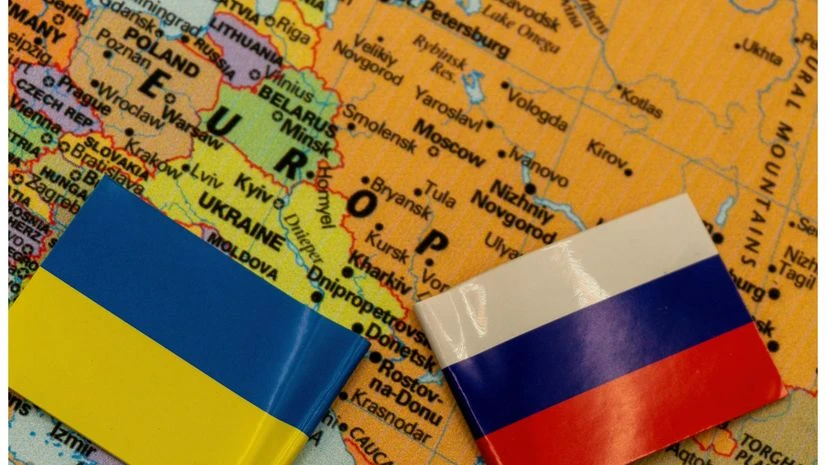)
Little reliable information about the surprise Ukrainian operation has emerged, and its strategic aims are unclear (Photo: Shutterstock)
Russia declared a federal-level emergency in the Kursk region following a large-scale incursion from Ukraine and sent reinforcements there on Friday, four days after hundreds of Ukrainian troops poured across the border in what appeared to be Kyiv’s biggest attack on Russian soil since the war began.
Meanwhile, a Russian plane-launched missile slammed into a Ukrainian shopping mall in the middle of the day, killing at least 11 people and wounding 44 others, authorities said.
The mall in Kostiantynivka, in the eastern Donetsk region, is located in the town’s residential area. Thick black smoke rose above it after the strike.
This is another targeted attack on a crowded place, another act of terror by the Russians, Donetsk regional head Vadym Filashkin said in a Telegram post.
It was the second major strike on the town in almost a year. Last September, a Russian missile hit an outdoor market there, killing 17.
Russia’s Defence Ministry said that reinforcements were on their way to the Kursk region to counter Ukraine’s daring raid. Russia is deploying multiple rocket launchers, towed artillery guns, tanks transported on trailers and heavy tracked vehicles, the RIA-Novosti new agency said, citing the Defence Ministry.
The operational situation in the Kursk region remains difficult, Kursk acting governor Alexei Smirnov said on Telegram.
The Russian Defence ministry reported fighting in the western outskirts of Sudzha, about 10 kilometres (6 miles) from the border. The town has an important pipeline transit hub for Russian natural gas.
Social services and civic associations are providing assistance to people forced to flee their homes by the fighting, he said. The last Russian figure for evacuations in Kursk was 3,000.
Little reliable information about the surprise Ukrainian operation has emerged, and its strategic aims are unclear. Ukrainian officials have refused to comment specifically about the incursion, which is taking place about 500 kilometres (320 miles) southwest of Moscow.
But a top adviser to Ukraine President Volodymyr Zelenskyy said Thursday that border region attacks will cause Russia to start to realize that the war is slowly creeping inside of Russian territory. Myhailo Podolyak also suggested that the operation would improve Kyiv’s hand in the event of negotiations with Moscow.
Mathieu Boulegue, a defence analyst at the Chatham House think tank in London, said the Ukrainians appear to have a clear goal in mind, even if they’re not saying what it is.
Such a coordinated ground force movement responds to a clear military objective, yet unknown, that requires extreme operational security, Boulegue told The Associated Press in a telephone interview.
At the same time, the raid spooks the Russian public and delivers a slap in the face to Russian President Vladimir Putin, offering Ukraine a great PR coup, he said.
The attack is a massive symbol, a massive display of force (showing) that the war is not frozen, the war is coming to you, he said.
The assault came as the Ukrainian army toils to hold at bay an intense Russian push at places on the front line in eastern Ukraine, especially in the Donetsk region. Russian President Vladimir Putin has made clear he wants to capture the parts of Donetsk that the Kremlin’s forces don’t already occupy.
Russia declares federal level emergencies when there are more than 500 victims or damage exceeds 500 million rubles (about $6 million).
The Kursk fighting has earned considerable attention in Russian media, at the top of news websites and state television news broadcasts.
State TV channel Rossiya-1 devoted its first 10 minutes of its 11 am newscast Friday to various aspects of the situation. There wasn’t any reporting from the front, but the newscast led with video from the Russian Defence Ministry purportedly showing the destruction of Ukrainian military vehicles and a howitzer.
Much of the coverage was about the humanitarian situation — children being taken to shelters aboard buses, people in other regions gathering food and diapers and other supplies to be sent to Kursk.
The Institute for the Study of War, a Washington-based think tank, says Ukrainian forces have pressed on with their rapid advances deeper into the Kursk region, reportedly going up to 35 kilometres (20 miles) beyond the border.
The lack of a coherent Russian response to the Ukrainian incursion into Kursk and the reported rate of Ukrainian advance indicates that Ukrainian forces were able to achieve operational surprise, the Washington-based ISW said late Thursday.
A Russian Defence Ministry statement Friday said only that the military continues to repel the attempted invasion and is responding with airstrikes, artillery and troops on the ground.
Ukraine has also kept up its strategy of hitting rear areas with long-range drones, targeting military sites, oil refineries and other infrastructure.
Ukrainian drones attacked Russia’s Lipetsk region, which is about 300 kilometres (180 miles) from the Ukraine border, during Thursday night, authorities said.
Drones operated by Ukraine’s Security Service hit a military airfield there, a security official told The Associated Press on condition of anonymity because he was not authorised to speak publicly.
The airfield was a base for fighter jets and helicopters and more than 700 powerful glide bombs in storage, the source said.
Ukraine’s Army General Staff also confirmed the strike on Lipetsk-2 airfield Friday morning, saying it was used as a base for multiple Su-34, Su-35 and MiG-31 jets.
The Russian Defence Ministry said that 75 Ukrainian drones were shot down during the night, 19 of them over Lipetsk.
(Only the headline and picture of this report may have been reworked by the Business Standard staff; the rest of the content is auto-generated from a syndicated feed.)
First Published: Aug 09 2024 | 11:28 PM IST


































